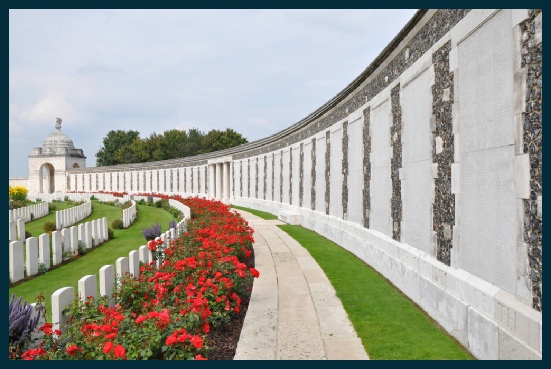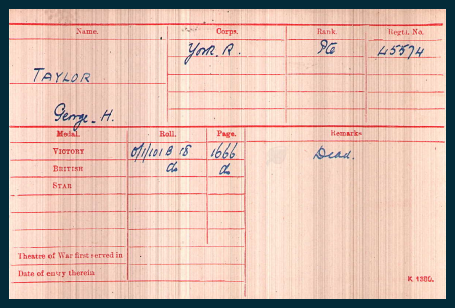Copyright © All rights reserved.



George Taylor

George Harold Taylor was the second son of Henry and Hannah (nee Waterworth) Taylor who married in the Malton area in the third quarter of 1873. He was born in the first quarter of 1883 and his birth registered in Malton. In 1891 Henry and Hannah and their three children were living at 3 Deviation Cottages in Huttons Ambo. Henry was working for the railway as a joiner and this small group of cottages near Huttons Ambo Station appear to be tied cottages for railway workers.
1891 Census – resident at 3 Deviation Cottages, Huttons Ambo
TAYLOR, Henry, Head, Married, M, 46, Joiner N.E.R., Malton Yorkshire,
TAYLOR, Hannah, Wife, Married, F, 39, , Bossall Yorkshire,
TAYLOR, William, Son, Single, M, 16, Brickyard Labourer, Malton Yorkshire,
TAYLOR, Alice M, Daughter, , F, 10, Scholar, Malton Yorkshire,
TAYLOR, George H, Son, , M, 8, Scholar, Huttons Ambo Yorkshire,
TAYLOR, John Rd, Son, , M, 5, Scholar, Huttons Ambo Yorkshire,
By 1901 the family had moved into Malton and the family had expanded; two older children had moved back in with their parents, Alice had married and she and her year-
1901 Census – resident at 2 Wright’s Yard, Malton
TAYLOR, Harry, Head, Married, M, 56, Joiner, Malton Yorkshire,
TAYLOR, Hannah, Wife, Married, F, 49, , Malton Yorkshire,
TAYLOR, William, Son, Single, M, 26, Plumber, Malton Yorkshire,
TAYLOR, Laura, Daughter, Single, F, 23, , Malton Yorkshire,
FOSTER, Alice, Daughter, Married, F, 21, , Malton Yorkshire,
TAYLOR, George, Son, Single, M, 18, Bricklayers Apprentice, Malton Yorkshire,
TAYLOR, John, Son, Single, M, 16, Grocer's Errand Boy, Malton Yorkshire,
TAYLOR, Harry, Son, Single, M, 7, , Malton Yorkshire,
TAYLOR, Elsie, Daughter, Single, F, 5, , Malton Yorkshire,
FOSTER, Charles, Grand Son, Single, M, 1, , Malton Yorkshire,
TAYLOR, Frank, Grand Son, Single, M, 0 (3 MOS), , Malton Yorkshire,
He married Alice Foster in the last quarter of 1904 in the Pocklington area. They had two sons, Fred, born in the first quarter of 1905 and Harold, born in the first quarter of 1909 as recorded in the 1911 census. They probably had another three children; Marjorie, born in the last quarter of 1911, Freda, born in the second quarter of 1914 and William born in the last quarter of 1916.
1911 Census – resident at 12 Wheelgate Square, Malton
TAYLOR, George, Head, Married 6 years, M, 28, Bricklayer, Hutton Ambo Yorkshire,
TAYLOR, Alice, Wife, Married 6 years, F, 28, , Bishop Wilton Yorkshire,
TAYLOR, Fred, Son, , M, 6, School, Malton Yorkshire,
TAYLOR, Harold, Son, , M, 2, , Malton Yorkshire,
The military career of George Taylor proved thoroughly elusive until the names were reversed. Then Harold George Taylor materialised! We do not know whether George volunteered shortly after the outbreak of war, but the fact that he is not recorded as being awarded the 1914-
Either way, he found himself in the 10th Battalion of the Yorkshire Regiment which was formed at Richmond in September 1914 and left England a year later, arriving in Boulogne on 10th September 1915.
Through most of the rest of 1915 and until March 1916, the 10th were stationed at Armentieres, alternating between billets and trenches throughout the cold winter months. Their role was typified by the diary entry for 24th February: “In billets. A quiet day. At 11 p.m. D Coy of the Battn undertook an enterprise against BLACK REDOUBT a portion of the enemy’s trench opposite no. 74 trench. The party (who had been training for the enterprise) consisted of 5 officers and 45 men… The object of the enterprise was to obtain prisoners, kill Germans, ascertain if any Gas apparatus had been installed in this sector and do general damage. The attack was unfortunately detected and our men were bombed by the enemy as they were getting over the enemy’s wire, causing a number of casualties and forcing our party to retire without having gained their object.”
On 23rd March, the Battalion was marched to Sternwercke where they underwent training for the rest of the month before returning to the front, this time at La Neuville. They spent April mainly in trenches, coming under heavy bombardment, though casualties seem to have been light. The diary comments “Men behaved wonderfully well throughout.”
Most of May was spent in billets or under canvas, drilling and working on construction of trenches, but they went back into the front line at the end of the month. June continued in much the same pattern, but July opened with three days pitched battle on the Somme. They then spent much of July under heavy bombardment suffering heavy casualties – it is noticeable that at this point the diary ceases to list every individual killed or wounded by name. During early August they were in the trenches engaged in digging deep dugouts and revetting the trenches, with very little enemy activity. From the snow and pouring rain earlier in the year it was now uncomfortably hot.
On 18th August they moved to Arras where things continued much as before, with occasional shell attacks but very low casualties.
In September the weather reverted to heavy rain and the Battalion was moved to Albert. The entries for the 18-
“In front line. Turned very wet, 6” to 2ft of mud and slush. The usual bombardment going on the whole time, men very wet and uncomfortable. Tot of rum a blessing in early morning to them, food and water coming up very badly, owing to bad state of roads etc.
In front line, mud and slush awful. The usual shelling going on. Many wounded belonging to the troops we relieved were eventually got away. They were in a bad way through the wet & cold, and the inability & difficulty we had to get R.A.M.C. help to get them away.”
In October they moved by train to Villiers sur Ailly where they spent a week training before moving again to Fouqereuil where they spent a fortnight in Reserve trenches before moving into the front line once more, coming under extensive attack with “Rum jars” (large trench mortars which threw a heavy bomb a short distance. They were called Earth Mortars or Albrecht Mortars to differentiate them from the other type of heavy 'Mortar' which, in the German army, was actually a heavy howitzer, manned by the artillery)
In November they returned to the support trenches for the first week, and then back to the front line to trenches “in a very bad condition, falling in faster than we can put them up again.” They continued to alternate on a weekly basis throughout November and December.
The whole of January 1917 was spent in training at Marles-
April continued with a further selection of marches until by 9th April they found themselves in the front line southeast of Henin-
On 1st October the Battalion marched to No. 2 Area near Dickiebusch Lake and the following day to Zillebeke Lake where they came under shellfire, losing two men. The next day they moved forward to take up positions for a planned attack, arriving at Glencorse Wood on the early morning of the 4th and coming under a heavy barrage. At 1.30 a.m. “D” & “B” companies lost touch with the other forces, while “A” & “C” companies remained in contact but before reaching their positions came under more heavy fire and the order was given to shelter in shell-
In the second quarter of 1923 Alice re-
George is commemorated on the Town Memorial and in St Leonard's Church.
